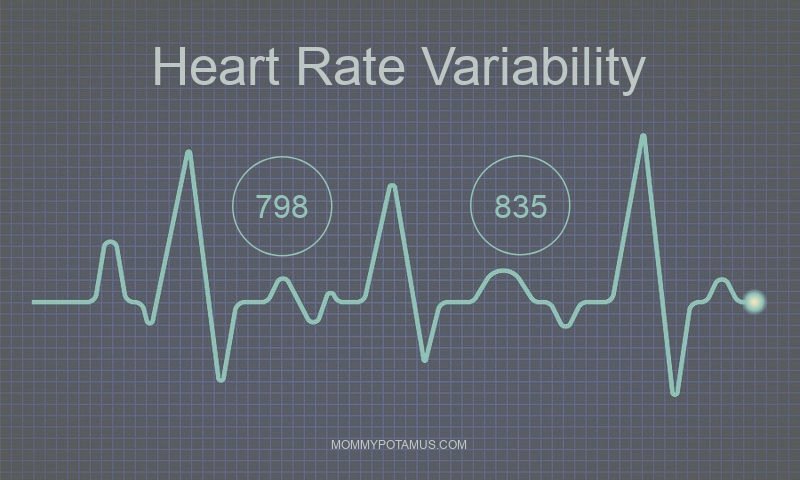
If you’re like me, you’ve probably spent most of your life thinking of your heart as a kind of metronome – a muscle that beats at a regular rhythm that adjusts up or down based on activity level. That is, when you think about it at all, which is probably not often.
BUT – what if I told you that your heart is not a metronome, and measuring the variations in its rhythm can offer insight into your physical and emotional well-being? (1) And not just that – what if I said it might be able to increase your awareness of how different wellness practices impact you personally, making it easier to prioritize what matters most?
That, my friends, is the benefit of measuring heart rate variability.
In this article we’ll dive into what it is, how it’s tied to well-being, how to measure it, and how to improve it. As always, none of these statements have been evaluated by the FDA, this article is not medical advice, and it’s not meant to diagnose or treat any condition. If you have a question about whether any wellness practice is right for you, please talk with a qualified healthcare professional. Now that we’ve got that out of the way, you might be wondering . . .

What is heart rate variability?
Heart rate variability, or HRV for short, measures slight fluctuations in time between your heartbeats. For example, let’s say your heart rate is 60 beats per minute. Instead of beating at perfect one second intervals, your heart might beat after 0.8 seconds followed by 1.2 seconds.
That’s because although your heart has an internal pacemaker called a sinoatrial node, it’s also hardwired to receive instructions from both sides of your autonomic nervous system. (2)
- Your sympathetic nervous system, aka your “fight or flight” response, tells your heart when to speed up so you can respond appropriately to exercise, a stressful moment, or illness.
- Your parasympathetic nervous system, aka the “rest and digest” response, tells your heart when to slow down so that your body can focus on recovery, digest food, etc.
When your nervous system is flexible and responsive, you’ll see a lot of slowing down and speeding up as your body reacts to life in real time. This increase in fluctuation is called high HRV.
As you can see in the image above, the fluctuation between heartbeats is significant, meaning that both sides are giving input. In this situation, your nervous system would be considered balanced and flexible, able to adapt to life as it unfolds. However, when one half of the nervous system is overriding the other (usually the fight or flight response), it tends to produce less variation.
Because the fluctuations are so small – we’re talking milliseconds here – they’re only detectable with the help of external devices. Traditionally, doctors have used EKGs to get a snapshot of HRV during a specific moment in time, but now there are wearable devices like the Oura ring which can provide a more complete picture – for example, whether HRV is trending up or down over time, what improves it, and what causes it to tank.
Why is HRV an indicator of well-being?
High HRV is associated with better physical and mental health. (3) It’s an indicator that your autonomic nervous system is balanced, adaptable, and capable of responding to the environment/new situations effectively. In one study that examined long-term outcomes after a cardiac event, patients with moderate HRV had a 400% lower risk of mortality than those with low HRV. (1)
According to the Cleveland Clinic, another benefit is that:
People with high heart rate variability are usually less stressed and happier.” (4)
With that said, there are times when you might want your heart rate variability to be low temporarily. Let’s say, for example, that you’re running away from a lion or lifting heavy weights during a workout. At that moment you want your sympathetic nervous system to take over and temporarily “mute” the influence of the parasympathetic system, so that it can properly elevate your heart rate and deliver oxygen to your muscles. In that moment your HRV would be low (dominated by one side), and it’s a beneficial adaptive response.
On the flipside, if you’re going about life as usual and your HRV starts to drop, it may be an indicator that your body is overtaxed in some way – dehydration, exhaustion, stress or illness, for example.
Personally, when I see that my HRV has dropped below my normal, I try to make lifestyle adjustments that will help raise it back up before taking on more challenges. Sometimes I have to try to bring it back up while dealing with a challenge I can’t press pause on – but either way, knowing which way my HRV is trending helps me make real-time decisions about when to rest and when to lean-in to challenges.
What is a healthy HRV?
HRV is highly individual. It can vary from day-to-day, and different people will have different average baselines. It’s partly influenced by factors we can’t control – for example, it tends to go down as we age and men generally have a slightly higher baseline than women – but it’s also significantly affected by our choices.
That’s why instead of comparing HRV with others, a more helpful measure to track is how your average is trending over time. Using your scores as a guide, you can gain insight into how different activities impact you personally.
With that in mind, here are some things that can raise – or drop – heart rate variability . . . .

Factors That Impact Heart Rate Variability
Though this is not an exhaustive list, some common factors that influence HRV are:
Exercise/Movement – Moderate intensity exercise increases HRV by dampening the overall influence of the sympathetic nervous system while also enhancing vagal tone. (5) Be aware, though, that overtraining can actually lower HRV, so it’s important to take time for recovery between workouts.
Sleep Quality – HRV operates on a circadian rhythm, and it’s highest at night when we’re sleeping. (6) As you can probably guess, prioritizing deep, restorative sleep leads to a higher overall HRV. Interestingly, raising HRV levels during the waking hours increases sleep efficiency, which is the amount of time in bed actually sleeping (versus just trying to sleep). (7)
In other words, working to raise HRV during the day may improve your quality of sleep at night, and prioritizing sleep can improve your overall HRV.
Nutrition – In general, a nutrient-dense diet appears to positively impact HRV, while a diet rich in processed foods seems to negatively impact it. For example, in this study, consuming omega-3 rich fish increased HRV, while in this one consuming unhealthy trans fats reduced HRV. Additional research suggests that specific micronutrients such as vitamin D and vitamin B-12 may be associated with higher HRV. (3)
Stress Level – HRV is an indicator of our overall stress levels, both physical and emotional, so it’s no surprise that finding ways to manage stress can improve HRV.
Some of my favorite tools for increasing stress resilience are adaptogenic herbs, calming herbs like California poppy, 10-15 minutes of yoga every morning, 10-20 minutes of breath work with my Heartmath EmWave2 around lunch, and time with loved ones in the evening. I also work forest bathing, cold plunges, sauna therapy, and ear seeding in throughout the week.
Hydration (Or lack of it) – Dehydration negatively affects HRV, so make sure to drink plenty of purified water. (8)
Illness – Both acute and chronic illnesses are associated with reduced HRV.
What are the benefits of tracking HRV?
Your doctor can measure HRV in the office using an EKG, but the reading only offers a quick snapshot in time. In order to figure out how you respond to different stressors and wellness practices from day to day, you’ll need a wearable device that either measures overnight or first thing in morning.
By measuring during sleep (which also happens to be when HRV is highest) or right when you wake up, you eliminate the “data noise” of little stressors throughout the day. Instead, you’re getting a picture of how well your nervous system is functioning when it’s relatively unbothered by random events.
HRV more than just a passive metric, though. When I check my score each morning, I mentally review the previous day and identify the factors that likely raised (or lowered) my HRV when I finally crawled into bed. For me, it’s provided insights into things like:
- Nutrition (Does eating most of my carbs at dinner support or impair parasympathetic activity? Does eating a particular food that I suspect I’m sensitive stress my body and lower my HRV?)
- Sleep (When I drop my bedroom sleep temperature for a few weeks does it raise or lower my HRV? How does the timing of when I go bed impact it?)
- Stress (What are the tools that best help me counteract life’s stresses? Yoga? Time outside? Cold plunges? Breathwork?)
- Illness (My HRV score is lower than usual, am I feeling run down or sick? Maybe this is a good day take it easy and support my immune system.)
Using the insights I’ve gained, I’ve been able to make adjustments that support both my emotional and physical health.

Wearable Options for Tracking Heart Rate Variability
Although an in-office EKG has long been considered the most reliable way to measure HRV, wearable devices using PPG technology are increasing in accuracy. In a head-to-head test conducted by Marco Altini, who holds a PhD in machine learning, the Oura ring was by far the most accurate. (9)
I’ll dive into its pros and cons below, along with several options to consider (including a very affordable one):
Best Overall – Oura Ring
As you can see in the photo above, this is the device that I use and love. Here’s why:
Benefits:
Accuracy – According to Marco Altini, the Oura ring’s readings were nearly identical to the EKG data that was taken simultaneously. I personally have found it to be very reliable in detecting elevations in my temp (both due to fever and natural hormonal shifts throughout my cycle), higher HRV after I initiated focused efforts to increase it, lower HRV when I let self-care slide, etc.
Motivation – For me, seeing the connection between my day-to-day activities and the well-being of my nervous system motivates me to make better choices. I don’t just think that ten minutes of stretching and breathwork in the morning and at lunch will improve my nighttime HRV, I know it.
That makes it easier to set aside that time instead of using it to do one of a dozen other things on my list. Over time, I’ve found that when my nervous system is more balanced I get more done anyway. I don’t freeze up and/or burn out easily like I have when my nervous system was overtaxed.
Full Night Measuring – Some devices “sample” HRV one or more times per night, which doesn’t offer an accurate picture. That’s because HRV goes up and down based on sleep stage, so you need to track the whole night to get an accurate reading. The other option is to measure first thing in the morning before any activity. Oura uses a full night of data to calculate HRV, not just a few samples.
Comfort – Unlike wrist strap devices that have to be worn tightly in order to get an accurate reading, the Oura ring is able to take highly accurate readings without being pressed against the skin. The difference comes down to the light is uses to detect HRV – most devices use green LED light, but the Oura uses infrared.
Durability – Oura rings are water resistant up to 100 meters (about 330 feet), which means you can shower, wash dishes and snorkel while wearing it. It’s also relatively resistant to heat and cold. According to Oura, hot tubs, saunas, ice baths, and cryotherapy tanks are all safe. Oura’s operating temperature ranges from (-10)°C – 52°C / 14°F – 125°F. My sauna gets hotter than 125F so I take my ring off before I get in.
Airplane Mode – I try to avoid EMF exposure whenever possible, which is why my house doesn’t have wifi and I use an EMF shielding case on my phone. All HRV wearables communicate the data they collect to your phone via bluetooth or wifi, but only a few have the option to switch into airplane mode to eliminate EMFs.
With Oura, I’m able to place my ring on its charger to automatically activate bluetooth. From there, I open my phone and let the ring sync the data, then I turn the ring back into airplane mode using the app before I put it back on. The whole process takes a maximum of two minutes a day, and my ring never emits bluetooth when I’m wearing it.
Downsides:
Cost – An Oura ring is an investment. Mine was actually a gift (from an individual, not the company) and I probably wouldn’t have purchased one for myself otherwise. However, when I realized how much valuable information I was getting I bought one for my husband and eventually my teenage daughter.
As she gets older, she’s going to need to decide if the wellness practices that have been part of our family culture are worth carrying into her adult life. I want her to, obviously, so I bought her a ring to help her see the real impact these practices have on her physiology.
Membership – Membership is not required to track three metrics (Sleep, Readiness & Activity), but additional data is only available via a monthly app subscription. The subscription option comes with some pretty helpful features like a detailed sleep analysis, period prediction, and detection of blood oxygen levels.
Most Affordable – Phone Camera
Most phones have both a camera and a light emitting diode, which can be used to take morning HRV readings with the help of the HRV4Training app.
Pros
Affordable – You probably already have a phone that will work, and the HRV4Training app is only $10.
Can Work Solo or With A Wearable – If you have a wearable like an Oura ring, you can integrate it with this app for deeper insights into your HRV if you want to. I personally feel like I get enough info from my Oura insights, but if I was training for a marathon or something I might consider it.
Cons
Does not provide as much overall data as Oura (detailed sleep analysis, etc.)
You have to manually collect the data (It only takes a minute, though)
Other Devices I Considered
Here are some options I considered for my husband and daughter:
Polar Chest Strap – This wireless strap can be used to gather a morning reading. Although it’s technically a heart rate monitor, from what I understand you can calculate HRV by initiating a “Fitness Test” that requires you to lie still for five minutes. When the test is complete, you’ll see your HRV score. Although it’s a solid option, we ended up choosing a wearable that offers more data and doesn’t emit a signal while I’m wearing it.
Biostrap – There’s a lot to like about this wearable. It has an airplane mode and measures a lot of the same things Oura does (HRV, sleep, oxygen saturation, etc.). However, as far as I can tell, it doesn’t measure continuously at night, has to be worn snugly, and is “splash proof” but not waterproof.
WHOOP – This wristband wearable isn’t bulky like some others, and it comes in lots of attractive colors. However, it can’t be switched into airplane mode, which means it transmits data via bluetooth continuously. Also, you HAVE to subscribe to their app to access your data. With Oura you can upgrade for more info, but you don’t have to keep an active membership.
Apple Watch – As I mentioned earlier, collecting a few five minute samples throughout the night doesn’t offer an accurate picture of HRV. Unfortunately, that’s what the Apple Watch does. If you already have one, you can use it with the HRV4Training app to take a morning reading that will be more meaningful. Although it would limit some of the Apple Watch’s features, I recommend keeping it in airplane mode as often as possible.
Garmin Watch – Testing done by Marco Altini, PhD found that Garmin’s HRV readings were inaccurate.
Want to know how to improve your HRV?
Click here for 12 research-backed ways to raise HRV.
Questions? Let me know in the comments below!
- Fred Shaffer et. al. (2014) A healthy heart is not a metronome: an integrative review of the heart’s anatomy and heart rate variability
- Anthony H. Kashou et. al. (Updated 2022) National Library of Medicine: Physiology, Sinoatrial Node
- Adrian L Lopresti (2020) Association between Micronutrients and Heart Rate Variability: A Review of Human Studies
- Cleveland Clinic. Heart Rate Variability
- Faye S Routledge (2010) Improvements in heart rate variability with exercise therapy
- Juha T. Korpelainen et. al. (1997) Circadian Rhythm of Heart Rate Variability Is Reversibly Abolished in Ischemic Stroke
- J. Gouin et. al. (2013) Heart rate variability predicts sleep efficiency
- Hayley A. Young et. al. (2019) Autonomic adaptations mediate the effect of hydration on brain functioning and mood: Evidence from two randomized controlled trials
- Marco Altini (2020) What you need to know about Heart Rate Variability (HRV) data collected during the night




